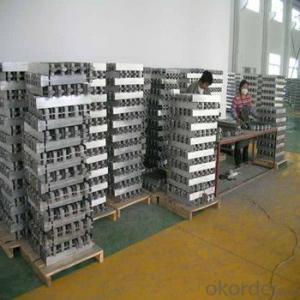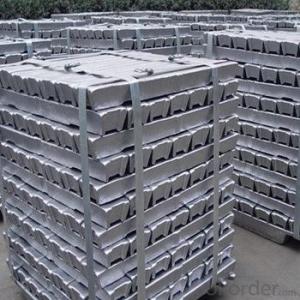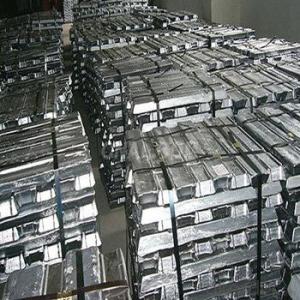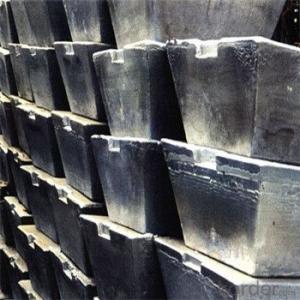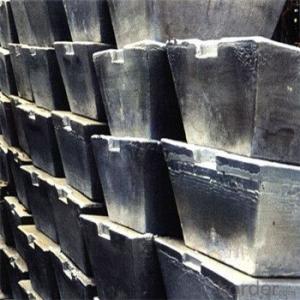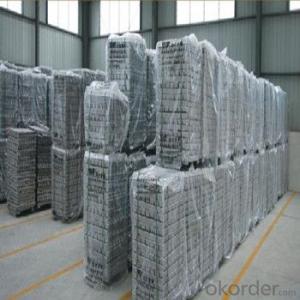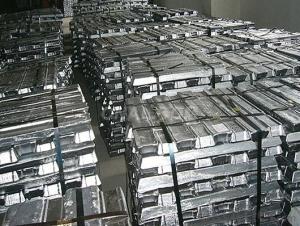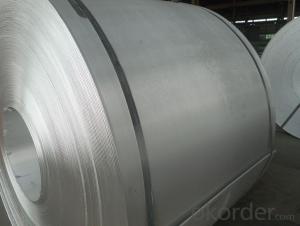Aluminium Ingot With High Grade 99.7% For Hot Sale
- Loading Port:
- China main port
- Payment Terms:
- TT OR LC
- Min Order Qty:
- 1000 m.t
- Supply Capability:
- 10000 m.t/month
OKorder Service Pledge
OKorder Financial Service
You Might Also Like
Pure Aluminum Ingot Used for Industry
1.Structure of Aluminum Ingot Description
An ingot is a piece of material, usually metal, that is cast into a shape suitable for further processing. Insteelmaking, it is the first step among semi-finished casting products. Ingots usually require a second procedure of shaping, such as cold/hot working, cutting, or milling to produce a useful final product. Non-metallic and semiconductor materials prepared in bulk form may also be referred to as ingots, particularly when cast by mold based methods.
2.Main Features of the Aluminum Ingot
•High Purity
•High strength
•Fast melting
•Best price
•Good after-service
3. Aluminum Ingot Images
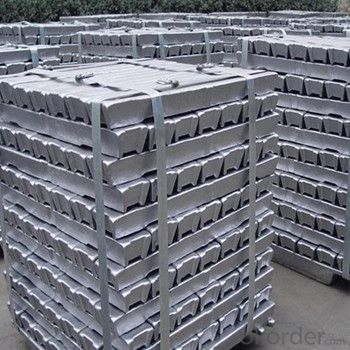
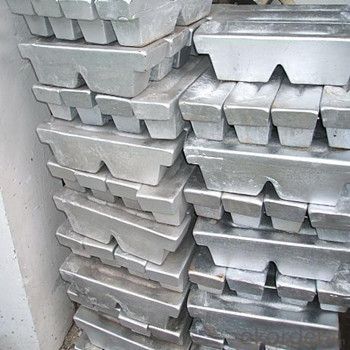
4. Aluminum Ingot Specification
Grade | Chemical Composition % | |||||||||
Al≥ | impurities ≤ | |||||||||
Si | Fe | Cu | Ga | Mg | Zn | Mn | others | Sum | ||
Al99.9 | 99.90 | 0.50 | 0.07 | 0.005 | 0.02 | 0.01 | 0.025 | - | 0.010 | 0.10 |
Al99.85 | 99.85 | 0.80 | 0.12 | 0.005 | 0.03 | 0.02 | 0.030 | - | 0.015 | 0.15 |
Al99.7 | 99.70 | 0.10 | 0.20 | 0.010 | 0.03 | 0.02 | 0.030 | - | 0.030 | 0.30 |
Al99.6 | 99.60 | 0.16 | 0.25 | 0.010 | 0.03 | 0.03 | 0.030 | - | 0.030 | 0.40 |
Al99.5 | 99.50 | 0.22 | 0.30 | 0.020 | 0.03 | 0.05 | 0.050 | - | 0.030 | 0.50 |
Al99.00 | 99.00 | 0.42 | 0.50 | 0.020 | 0.03 | 0.05 | 0.050 | - | 0.050 | 1.00 |
5.FAQ of Aluminum Ingot
We have organized several common questions for our clients,may help you sincerely:
①How about your company?
A world class manufacturer & supplier of castings forging in carbon steel and alloy steel,is one of the large-scale professional investment casting production bases in China,consisting of both casting foundry forging and machining factory. Annually more than 8000 tons Precision casting and forging parts are exported to markets in Europe,America and Japan. OEM casting and forging service available according to customer’s requirements.
②How to guarantee the quality of the products?
We have established the international advanced quality management system,every link from raw material to final product we have strict quality test;We resolutely put an end to unqualified products flowing into the market. At the same time, we will provide necessary follow-up service assurance.
③How long can we receive the product after purchase?
In the purchase of product within three working days, We will arrange the factory delivery as soon as possible. The pecific time of receiving is related to the state and position of customers.Commonly 7 to 10 working days can be served.
- Q:What are the advantages of using aluminum ingots in the production of electrical transmission lines?
- There are several advantages of using aluminum ingots in the production of electrical transmission lines. Firstly, aluminum is a lightweight metal, which makes it easier to transport and install compared to other materials such as copper. This reduces the overall costs and effort involved in the construction and maintenance of transmission lines. Secondly, aluminum has excellent conductivity properties, which allows for efficient transmission of electricity. This means that less energy is lost during the transmission process, resulting in higher efficiency and reduced power wastage. Moreover, aluminum is highly resistant to corrosion, which is crucial for outdoor applications. It can withstand harsh weather conditions and environmental factors, ensuring the longevity and reliability of the transmission lines. Additionally, aluminum is a cost-effective option compared to other metals like copper. The abundance of aluminum ore and its relatively low cost of extraction makes it a more affordable choice for large-scale transmission line projects. Furthermore, aluminum is a highly recyclable material, making it an environmentally friendly option. The recycling process of aluminum requires significantly less energy compared to the production of virgin aluminum, reducing carbon emissions and energy consumption. Lastly, aluminum ingots can be easily molded into various shapes, allowing for flexibility in the design and construction of transmission lines. This makes it easier to adapt to different terrain and installation requirements, ensuring the optimal functionality of the electrical grid. In conclusion, the advantages of using aluminum ingots in the production of electrical transmission lines include lightweight, high conductivity, corrosion resistance, cost-effectiveness, recyclability, and flexibility. These benefits make aluminum a preferred choice for the efficient and sustainable transmission of electricity.
- Q:How do aluminum ingots contribute to the circular economy?
- Aluminum ingots play a significant role in contributing to the circular economy due to their recyclability and multiple applications. The circular economy is an economic system aimed at minimizing waste and maximizing the value of resources by promoting reuse, recycling, and remanufacturing. One key aspect of aluminum ingots is their recyclability. Aluminum is one of the most recycled materials globally, with a recycling rate of around 70-80%. This means that a large portion of aluminum used in various products can be recycled and transformed into new aluminum ingots. This recycling process requires significantly less energy compared to primary aluminum production, resulting in reduced greenhouse gas emissions and a lower environmental footprint. Moreover, aluminum ingots have numerous applications across various industries, including construction, automotive, aerospace, packaging, and electronics. By using recycled aluminum ingots, these industries can reduce their dependence on virgin (primary) aluminum extraction, which is an energy-intensive process. The use of recycled aluminum ingots not only conserves natural resources but also helps in reducing carbon emissions associated with primary aluminum production. Additionally, the circular economy approach encourages the design and production of products with recyclability in mind. Aluminum ingots can be easily melted down and reshaped into various forms, allowing for the creation of new products while maintaining their quality. This closed-loop system ensures that aluminum remains in circulation, reducing the need for raw material extraction and minimizing waste generation. In conclusion, aluminum ingots contribute to the circular economy by being highly recyclable, enabling the transformation of waste aluminum into valuable resources. Their use in various industries promotes sustainability, reduces energy consumption, and minimizes waste, making aluminum ingots an essential component in the transition to a more circular and resource-efficient economy.
- Q:How are aluminum ingots shaped into different forms?
- Aluminum ingots are shaped into different forms through a process called aluminum extrusion. This process involves heating the aluminum ingot until it reaches a molten state. The molten aluminum is then forced through a specifically designed die, which determines the shape and size of the final product. The die is a hollow profile with the desired shape, and it acts as a mold for the molten aluminum. Once the molten aluminum passes through the die, it undergoes a cooling process, which solidifies it into the desired shape. The cooling process can be done through various methods, including air cooling or water quenching. The method used depends on the specific requirements of the product. After the aluminum has cooled and solidified, it is then cut into the desired length. This can be done either during or after the extrusion process, depending on the complexity of the shape or the requirements of the product. Aluminum extrusion allows for a wide range of shapes to be produced, including solid profiles, hollow sections, tubes, and intricate designs. The process is highly versatile and efficient, making it a popular choice for shaping aluminum into different forms. Additionally, the lightweight and corrosion-resistant properties of aluminum make it an ideal material for a variety of applications, from construction and automotive industries to consumer goods and electronics.
- Q:102 non-standard aluminum ingot is like? And ordinary non-standard aluminum ingot what is the difference?
- Nonstandard 102 is aluminium ingot produced by waste aluminium smelting, containing silicon between 8-12%, and remaining iron, zinc and copper content below 1Lower quality requirements for die casting aluminium ingots
- Q:Can aluminum ingots be used in the production of musical instruments?
- Musical instruments can indeed be produced using aluminum ingots. Aluminum, a lightweight and adaptable metal, possesses various characteristics that render it suitable for musical instruments. Its malleability and ease of manipulation enable the crafting of intricate designs and intricate components. Moreover, aluminum's resistance to corrosion aids in preserving the instrument's quality and lifespan. Furthermore, aluminum boasts excellent resonant properties, resulting in the production of crisp and lively sound. To enhance performance and durability, numerous instruments like trumpets, flutes, and saxophones incorporate aluminum in their construction.
- Q:What are the advantages of using aluminum ingots in the production of medical devices?
- There are several advantages of using aluminum ingots in the production of medical devices. Firstly, aluminum is a lightweight metal, making it ideal for medical devices that need to be portable and easy to handle. It reduces the overall weight of the device, making it more comfortable for patients and easier for healthcare professionals to use. Secondly, aluminum has excellent corrosion resistance properties. This is crucial in medical devices as they often come into contact with various bodily fluids and chemicals. By using aluminum ingots, manufacturers can ensure that the medical devices will not corrode or degrade over time, thus increasing their lifespan and reliability. Additionally, aluminum is highly malleable and can be easily shaped and formed into intricate designs. This allows for the production of complex medical devices with precise specifications. The versatility of aluminum ingots enables the creation of devices that can fit various anatomical structures, ensuring a better fit and improved functionality for patients. Furthermore, aluminum is a non-toxic material and does not react with human tissues. It is biocompatible, meaning it can be safely used in medical devices that come into direct contact with the body, such as implants, surgical instruments, and prosthetics. Aluminum's biocompatibility reduces the risk of adverse reactions or complications for patients. Lastly, aluminum ingots are cost-effective compared to other metals commonly used in medical device production. The abundance of aluminum ore and its relatively low cost of extraction make it a more affordable option for manufacturers. This cost-effectiveness can lead to more accessible medical devices, benefiting patients and healthcare systems worldwide. In conclusion, the advantages of using aluminum ingots in the production of medical devices include their lightweight nature, excellent corrosion resistance, malleability, biocompatibility, and cost-effectiveness. These properties make aluminum a suitable choice for creating high-quality, durable, and safe medical devices.
- Q:The difference between electrolytic aluminium, alumina and aluminium ingot
- You said, "the aluminum factory also needs bauxite," then the aluminum smelter is not necessarily a single electrolytic aluminum plant, there may be other production processes.
- Q:What are the different welding methods for aluminum ingots?
- There are several welding methods that can be used for aluminum ingots, including Tungsten Inert Gas (TIG) welding, Metal Inert Gas (MIG) welding, and oxyacetylene welding. TIG welding is commonly used for its precision and control, while MIG welding offers faster and more efficient welding. Oxyacetylene welding, on the other hand, is an older method that uses a flame to heat and melt the aluminum. Each method has its own advantages and is chosen based on the specific requirements of the project.
- Q:Does the pure aluminium ingot need to be removed in addition to the slag after melting?
- The pure aluminum ingot also needs to be removed in addition to the slag after melting. Because there will be air absorption in the process of melting, the slag will also be generated.
- Q:How are aluminum ingots used in the production of architectural facades?
- Aluminum ingots play a crucial role in the production of architectural facades. These ingots are the primary raw material used to manufacture various aluminum products, including facades. To begin with, the ingots are melted and then cast into different shapes and forms, such as sheets or extrusions, depending on the design requirements of the facade. This casting process allows for customization and flexibility in creating architectural elements with different sizes, profiles, and finishes. Once the aluminum is transformed into its desired form, it undergoes further processing, such as cutting, bending, and machining, to achieve the specific design details required for the facade. This flexibility allows architects and designers to create intricate patterns, shapes, and textures, enhancing the overall aesthetic appeal of the building's exterior. Additionally, aluminum ingots possess excellent strength-to-weight ratio and corrosion resistance properties. These characteristics make aluminum an ideal choice for architectural facades as it can withstand harsh weather conditions, including heavy rain, strong winds, and extreme temperatures, without compromising its structural integrity. Moreover, aluminum facades are known for their durability and low maintenance requirements. The corrosion resistance of aluminum ensures that the facade can retain its original appearance for an extended period, reducing the need for frequent repairs or replacements. Furthermore, aluminum is a sustainable material as it can be recycled repeatedly without losing its quality. This recyclability aspect makes it an environmentally-friendly choice for architectural facades, aligning with the increasing focus on sustainable construction practices. In conclusion, aluminum ingots are essential in the production of architectural facades due to their versatility, strength, durability, and sustainability. The ability to mold aluminum into various shapes and forms allows for the creation of visually appealing and functional facades that withstand the test of time and contribute to sustainable building practices.
1. Manufacturer Overview |
|
|---|---|
| Location | |
| Year Established | |
| Annual Output Value | |
| Main Markets | |
| Company Certifications | |
2. Manufacturer Certificates |
|
|---|---|
| a) Certification Name | |
| Range | |
| Reference | |
| Validity Period | |
3. Manufacturer Capability |
|
|---|---|
| a)Trade Capacity | |
| Nearest Port | |
| Export Percentage | |
| No.of Employees in Trade Department | |
| Language Spoken: | |
| b)Factory Information | |
| Factory Size: | |
| No. of Production Lines | |
| Contract Manufacturing | |
| Product Price Range | |
Send your message to us
Aluminium Ingot With High Grade 99.7% For Hot Sale
- Loading Port:
- China main port
- Payment Terms:
- TT OR LC
- Min Order Qty:
- 1000 m.t
- Supply Capability:
- 10000 m.t/month
OKorder Service Pledge
OKorder Financial Service
Similar products
New products
Hot products
Hot Searches
Related keywords
